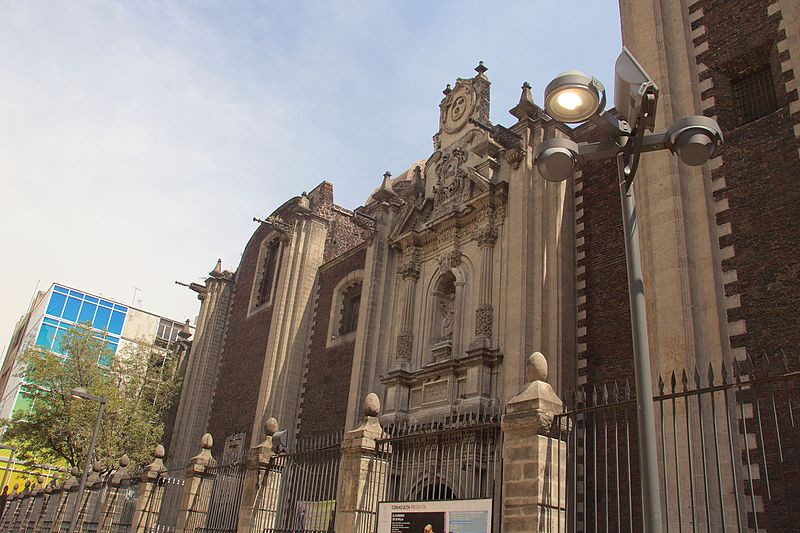
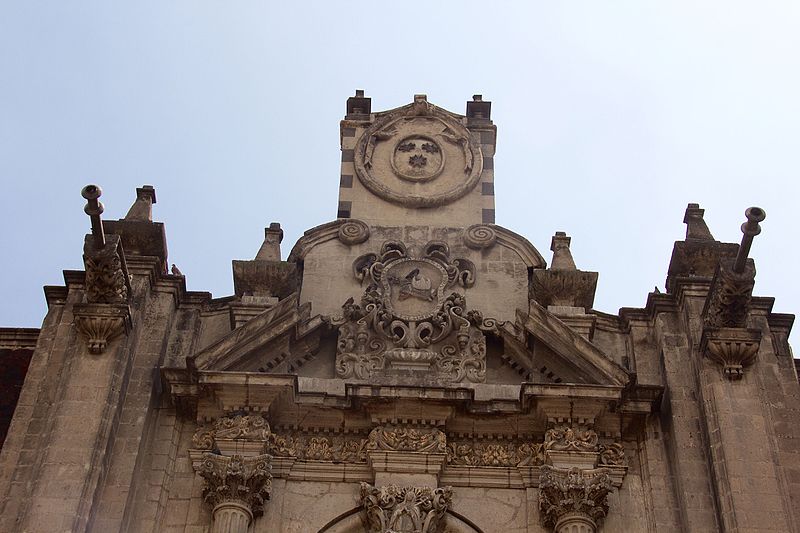
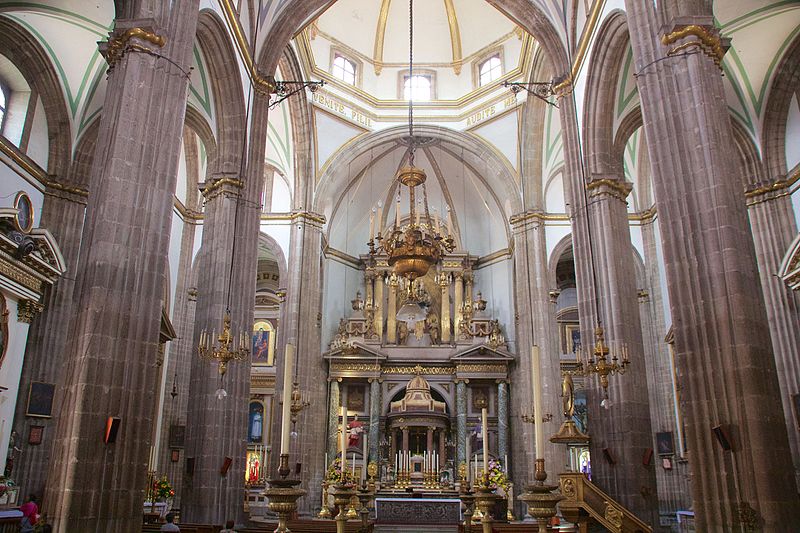

Photos: Mike Peel (www.mikepeel.net), Attribution-Share Alike 4.0 International
Mexico City’s “other cathedral,” La Profesa has long been an austere presence on the corner of Plateros Street, today’s Avenida Madero. Although it’s today less-gawked-at or quietly ignored, it’s still a remarkable and shadowy presence. Home to one of the city’s most important religious art collections, it’s been a residential home to dozens of Jesuits. It’s been the seat of the Arch-Bishop. It’s been closed and remodeled, and still it quietly stands a few hundred meters from the Metropolitan Cathedral, in its resigned majesty.
An 18th-century Baroque temple, it’s officially called the Oratory of Saint Philip Neri. The church belongs to the organization of the same name. Originally part of an architectural complex called La Casa Profesa, Jesuit priests here had taken a fourth vow of particular obedience to the Pope for doing missionary work.
An earlier temple at the site opened in 1610. That one was later replaced by the current building, designed and built by the celebrated Pedro de Arrieta. Built between 1714 and 1720, it has three naves, and remains a remarkable site.
In 1767, the Jesuits were expelled from all Spanish domains. La Profesa was then handed over to the Congregation of the Oratory of San Felipe Neri after their temple was mostly destroyed in an earthquake in 1768. Prior to that, their home was the celebrated Miguel Lerdo de Tejada Library on today’s Calle República de El Salvador. That street had previously been called Calle de San Felipe Neri.
By the beginning of the 19th century, la Profesa’s interior was redone in a neoclassical style. Manuel Tolsá designed another of his dramatic altarpieces. His Virgin of the Immaculate Conception, here, is said to be based on the socialite, María Ignacia Rodríguez de Velasco. She would go on later to assume prominent roles in the movement towards independence from Spain. But this is still just the beginning of some of the temple’s art, paintings, sculpture, and more.
While the Oratory Library has a number of exceptional books (8,014 to be precise), including remarkable 17th and 18th-century volumes from Mexican, Italian, and French publishing houses, it’s better known for the art gallery. The Pinacoteca contains many of the most important paintings from the 17th, 18th, and 19th centuries.
Opened only in 1978, the Pinacoteca galleries had been lavishly rehabbed and can be only sometimes be toured.
The temple is also remembered for having hosted one of the most important conspiracies against the independence movement. The conspirators gathered here in a series of ultra-secret meetings sympathizing with the idea of locating a Spanish-born absolute monarch in Mexico, even as a liberal constitutional monarchy was being planned in Spain under a king installed by Napoleon.
Later, during the Cristero War of 1926 – 1929, La Profesa served as the provisional cathedral for the city while the Metropolitan Cathedral was closed.
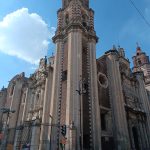 The Jesuits arrived in Mexico City at the end of the 16thcentury. They established a house for the professed of the fourth vow on Plateros Street (today's Avenida Madero). It's been called "La Profesa" since that time.
The architectural complex had two main courtyards and a service courtyard, lodging, chapels, a kitchen and other quarters. Everything was abandoned with the expulsion of the Society of Jesus from the entire Spanish dominion in 1767. The temple was rebuilt by Pedro de Arrieta between 1710 and 1714. It had a splendid Baroque interior with altarpieces and a great collection of works of art. By 1803 the temple and the house were in the hands of the Oratorio de San Felipe Neri of Mexico. The Philippine Fathers then commissioned Manuel Tolsá to redecorate the church. It currently has one of the best neoclassical interiors in the capital, with fine altarpieces and extensive decorations.
Since 1973 the Pinacoteca de La Profesa, a collection of more than 600 17-19th century paintings by Novo-Hispanic artists has been maintained inside. With the 2017 earthquake it was damaged and remains closed. Artists like Rodríguez Juárez, the Correa, and the Echave, and workshops such as those of Cristóbal de Villalpando, Miguel Cabrera, José de Alcíbar, and Antonio de Torres all painted for La Profesa.
The Jesuits arrived in Mexico City at the end of the 16thcentury. They established a house for the professed of the fourth vow on Plateros Street (today's Avenida Madero). It's been called "La Profesa" since that time.
The architectural complex had two main courtyards and a service courtyard, lodging, chapels, a kitchen and other quarters. Everything was abandoned with the expulsion of the Society of Jesus from the entire Spanish dominion in 1767. The temple was rebuilt by Pedro de Arrieta between 1710 and 1714. It had a splendid Baroque interior with altarpieces and a great collection of works of art. By 1803 the temple and the house were in the hands of the Oratorio de San Felipe Neri of Mexico. The Philippine Fathers then commissioned Manuel Tolsá to redecorate the church. It currently has one of the best neoclassical interiors in the capital, with fine altarpieces and extensive decorations.
Since 1973 the Pinacoteca de La Profesa, a collection of more than 600 17-19th century paintings by Novo-Hispanic artists has been maintained inside. With the 2017 earthquake it was damaged and remains closed. Artists like Rodríguez Juárez, the Correa, and the Echave, and workshops such as those of Cristóbal de Villalpando, Miguel Cabrera, José de Alcíbar, and Antonio de Torres all painted for La Profesa.
Heart of México Walking Route: Alameda Central - Av. Madero
< < Palacio de Iturbide| Museo del Estanquillo > >
Proyecto “Corredor de Cultura Digital”.
Nombre de la investigación: Investigación Centro Histórico, Monumentos, Edificios y Puntos de Interés (2023)
Dirección de investigación y diseño de Rutas: Acércate al Centro A.C. Guadalupe Gómez Collada
Coordinación e investigación histórica: Fideicomiso del Centro histórico Dir. Maestra Loredana Montes
 +52 (55) 5521 8362
+52 (55) 5521 8362

Nearest at 0.03 kms.
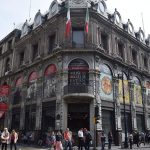
Nearest at 0.05 kms.

Nearest at 0.08 kms.

Among the strongest places to see historical and colonial period art works . . .

Bellas Artes has long been an iconic symbol of Mexico City's culture and performing arts.
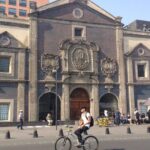
One of Pedro de Arrieta's most lasting contributions to the look and feel of the City.
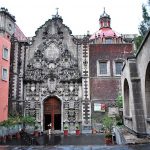
One of the oldest places on today's calle Madero, the temple is only accessible through a remaining side chapel.

One of the most eclectic of museums, at home in one of the most dynamic of late 19th century buildings.